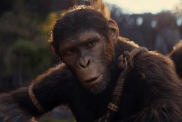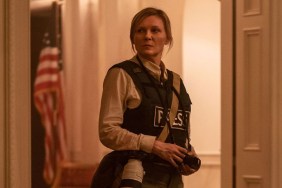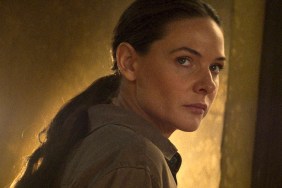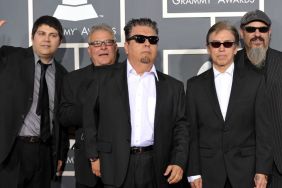
When most people think of the “Great American Western,” they may think of John Wayne or Clint Eastwood, but the America in question is almost always North America. Director Mateo Gil’s Blackthorn takes the genre down to Bolivia for what is essentially a rather reverential sequel to Roy Hill’s 1969 movie Butch Cassidy and the Sundance Kid, which starred a much younger Paul Newman and Robert Redford.
Gil has legendary actor Sam Shepard playing James Blackthorn, the former Butch Sundance, living in hiding in Bolivia decades after he and the Sundance Kid were presumed dead after being chased over a cliff by the Bolivian Army. James has an exit strategy and is just a day away from returning to the United States when he encounters a Spaniard, played by Eduardo Noriega, being chased by a posse after stealing money from a mine, and James begrudgingly agrees to help him. The movie also regularly cuts back to a time before the events of Hill’s classic film with Nicolak Coster-Waldau and Padraic Delaney playing the younger Butch and Sundance, and it stars Stephen Rea as a Pinkerton named MacKinley, who never believed Cassidy was dead, and is thrilled when they cross paths again. (Rea and Shepard have known each other for nearly forty years and have done much theater together, but Blackthorn is the first time they’ve been on screen together.)
Blackthorn was one of the nicest surprises at this year’s Tribeca Film Festival, a wide-screen Western that absolutely must be seen on the big screen if at all possible, and it’s held steady as our second favorite movie of the year since we saw it.
ComingSoon.net had a chance to sit down with Gil just a few days after his film’s Tribeca premiere for the following interview.
ComingSoon.net: I’m familiar with your screenwriting work for Alejandro Amenabar, and you directed another movie a while ago.
Mateo Gil: Yeah, many years ago.
CS: So was this movie something you’d been developing for a long time or was it something that came about more recently?
Gil: It seems to be recently, but actually, we have been working for three or four years. The first draft of the script was written maybe five years ago more or less, and at that time, I was working on developing another project. I was listening to Miguel the screenwriter and telling him my opinion and everything, but I was concentrating on the other one, but that fell through, and then I started thinking about directing this one.
CS: It’s surprising, because we’re so used to you writing your own material.
Gil: Yeah, yeah, yeah, It’s very true, because in Spain, every director complains about the same thing, that they have to write their own scripts always. And I’m a screenwriter and I’m doing a script from another person, which is great.
CS: Did you have to convince him or anyone else that you could direct it? It’s a pretty complex film.
Gil: No, no. He was pushing already, because he wasn’t well known at this moment, so he was saying to me, “If you don’t direct it, no one is going to buy this script, so please…” He was pushing, yeah.
CS: It was mostly filmed in South America?
Gil: The whole movie is shot in Bolivia.
CS: Was it mainly Spanish money but you shot it down there or did you have some backing from South America as well?
Gil: It’s mostly Spanish money, because we had a Bolivian co-production but they don’t have much money, so they did a lot of work. How do you say when there’s a local production company in the place that makes the schedules and contacts the people and everything. But they haven’t much money.
CS: I wouldn’t even think that Bolivia had much of a film industry. Was it hard finding the crews?
Gil: The crew, that was a lot of Bolivian people, but there’s no industry there so we were not very confident about the quality of the crews there, so the boss of every team was Spanish. But you know the Bolivian crew worked fantastically. They are good workers, hard workers, they never complain there. They’re very enthusiastic all the time.
CS: Were there any concerns about Miguel writing a script about Butch Cassidy, who is a very well known character, one that has been featured in an American film that everyone knows and loves?
Gil: Yeah, there were concerns. Lots. We had to decide, because being this story, the risk was there. Everyone is going to say, “Oh my God. The end of ‘Butch Cassidy and the Sundance Kid’ is so good. What are you doing?” We thought, “Okay, we love these Westerns by Roy Hill. Why not? We want to make an homage; we want to enjoy one more adventure. Why not?” It’s risky but at the same time, when I see the reactions here in the Tribeca Film Festival, I feel that they are kind of thankful, because someone is recovering this character and making one more chapter. I would like to see a movie like this.

CS: It’s great because usually, Hollywood would want to remake the original movie or make a really bad sequel, which seems to be happening more and more.
Gil: It’s very strange for me that there aren’t more movies about Butch Cassidy, because he was a really special character, the real Butch Cassidy, because he was not violent at all, and he had a really strong ideological thing behind all his hold-ups. He was a special character. I think the movie by Roy Hill is so good, that everybody thought, “Okay, this is finished forever.” (laughs) The real historical character is a very interesting person. Nowadays more than ever I think. There is a thin line that we try to draw in the movie, the line between robbing banks and big companies and robbing people. It’s not the same, and Butch Cassidy was very aware of this, and he didn’t rob just because of the money, he robbed because he was against all these big companies, so it’s a very special thing. He was kind of a Robin Hood of his time.
CS: Did Miguel or you or both of you do a lot of research about his history? Was this story based on something that really happened?
Gil: There is some research about Butch Cassidy and about the historical doubts about whether they were the two guys that were killed in Bolivia. There were some doubts about that. There had been some research about this question and there’s even a documentary about this expedition that went to Bolivia to dig out the corpse in order to prove if they were there, and they didn’t find them, so the doubts are already out there.
CS: Was this after they had developed DNA research they could use?
Gil: It was 1996. They were looking because the family of Butch Cassidy was really difficult to track, so they did the proofs with the family of the Sundance Kid, a grandson, but there was no Sundance DNA.
CS: Let’s talk about Sam Shepard, because he doesn’t do a lot of movies these days, and it’s an amazing catch to get him to play this role. And I assume he does all of his own riding.
Gil: All the time, all the time.
CS: That’s amazing to get an actor who can embody this character and do all his own riding. How did you approach him? Was it just a matter of sending him the script?
Gil: We contacted an English casting director Jina Jay who lives in London, and she has many contacts in Hollywood and she makes many American movies in Europe, so she’s very well known. Fortunately, I met her during the filming of “Agora,” and she was very kind and said, “Yes, I want to do it,” and it was done. She sent the script to Sam Shepard’s agent and it was very quick. He read the script and said, “I want to do it.” He didn’t ask who I was. Never. “I want to do it. I like the script.”
CS: He wasn’t concerned about going to Bolivia and riding his own horse?
Gil: Of course, of course! But above all, about the altitude, because it’s very high, all over 12,000 feet high, so you can lose your breath very easily. If you look very closely at the movie, thinking about it, you will see some things are like (he does a bit of speech breathing heavily).
CS: It must have been something that added to the delivery and seemed intentional.
Gil: But you know, the moments I saw Sam the happiest was when he had to ride. He’s like a child, and I think it’s the thing he likes the most.
CS: So you probably couldn’t have convinced him to use a stunt rider anyway.
Gil: No! (laughs) There are a few stunts in long, long shots, because we had to shoot some shots with a second unit, but the rest is all the time him, and you can see it.
CS: What about the rest of the cast? Because it’s a very diverse cast, a few from Spain, and you have Stephen Rea, a great Irish actor. It seems like such a small role but when he returns later in the movie, it’s quite amazing. Did you have Eduardo or Stephen in mind for those roles?
Gil: Yeah, a lot of it was in mind from the beginning, because we knew that we wanted a Spanish character because our natural market is Spain, so we had to have a good Spanish actor. Sam was in our mind, and Stephen, too. There was a small list, because we knew that it was going to be very difficult that such actors would even read the script, but we were very lucky. After Sam said “Yes,” he said, “What do you think about Stephen Rea because he’s a friend of mine?” And I thought, “Oh my God!”
CS: And he was already on your list?
Gil: So this was a lot of luck, so it was done. Stephen, once Sam told him, “Do you want to do this movie?”, he said, “Yes, if you’re in the movie, I’m in the movie.”

CS: Had they worked together on a movie before?
Gil: They worked a lot doing theater, Sam writing and Stephen acting. Actually, the last time I came here to see Sam, it was just before the shooting, maybe February last year, there was a theater play here written by Sam Shepard and starring Stephen Rea. I can’t remember the name but it was beautiful. (Note: He’s probably talking about “Ages of the Moon” from 2009.)
CS: What about shooting in Bolivia? Did you have time to go and scout locations beforehand?
Gil: I made three trips to Bolivia before the real trip to prepare shooting, so I can tell you that I saw thousands of kilometers of backroads, thousands. I know the High Plateau very well.
CS: Would you say that you know Bolivia even more than anyone in Bolivia?
Gil: You know, Bolivia is a huge country. The High Plateau is the third largest part.
CS: Was it hard finding places that had the same geography now as it would have had back then?
Gil: No, no. At the High Plateau, it was easier, because many places there remain exactly the same as a century ago. We had to do some work on the streets, but it was amazing, it’s like turning time back.
CS: Your DP really captured those landscapes beautifully, so I hope people will make the effort to see this in theaters on the big screen like I did.
Gil: Yeah, he’s great. You know, he’s Spanish, but he works in the United States. He’s lived here since 30 or 40 years ago, and he used to work a lot with David Mamet. He’s a great DP.
CS: Did you end up doing a lot of building on these landscapes such as the towns and such?
Gil: No, the villages are there. We just built two sets, the hotel set… the rest is nature. The ranch itself, natural and self-made, like an arrangement (chuckles) but the good thing about Bolivia is you can find beautiful places there.
CS: What about the music? I really liked the music a lot and you could have gone with Old Western or traditional Bolivian music but you made some interesting choices. Who is the singer on those folk songs?
Gil: Sam is the singer, Sam Shepard!
CS: No way. Really?
Gil: Yes. Didn’t you notice?
CS: I knew it was him singing when he was on screen singing, but there were a few songs playing while he’s riding. That’s him, too?
Gil: Yes, all the time. The thing is that I wanted to put traditional American songs in the movie, but we did not have enough money to buy the songs, it’s a small production and when we were shooting one day, Sam told me, “You know, I know some traditional American songs. I can play them to you.” And I went, “Oh my God, do you think we can put these songs in the movie?” He was happy singing, too. He likes to sing. I remember many nights during the shooting when he was at the hotel lobby and everybody around him, and he was playing traditional songs on his guitar.
CS: Between that and the score, it harks back to those old Westerns but it has its own thing, too. What about casting the younger Butch and Sundance? I think in theory, you probably could have gotten big name actors to play the roles, so did you have any specific actors in mind for those roles?
Gil: The thing was that for financial reasons, we needed all of them to be European, so the only American we could have was Sam. The rest of the actors should be European, so it was very difficult because we needed three young actors that were European but could do a very fine North American accent. At the same time, they had to be able to ride. But at the same time, they wanted young Butch to be very like Sam, so it was very difficult. (laughs)
CS: It’s surprising to see these great flashbacks with three actors who are complete unknowns.
Gil: They’re known in Europe. For example, the girl, Dominique McElligott, is doing some American movies and Nicolka Coster-Waldau, the young James, is making American movies, too. I know that Padraic (Delaney) is very well known in Ireland.
CS: Where do you go from here? You’ve made this amazing classic Western in Bolivia. What do you do next? Are you going to go back to that other project you wanted to do?
Gil: I have some ideas in my mind, and I have an already-written script, nothing to do with a Western, kind of a character drama with a small plot of science fiction.

CS: So maybe closer to “Open Your Eyes,” that kind of thing?
Gil: Yes, close to that. Actually, the idea came from this same time. When I was writing “Open Your Eyes,” I remember telling myself, there’s a thing missing here that I would like to recover one day. But in Europe, things are tough to raise (money for) projects, and this is not a very cheap project, but I don’t know. Let’s see.
CS: The movies you’ve done with Alejandro–“Open Your Eyes,” “The Sea Inside” and “Agora”–are all very different movies.
Gil: Yeah, I like to, I like to.
CS: You mentioned you wanted to do more science fiction, so do you have a preference for which genres you like? If you had to pick a movie to see, is there a genre that you generally like seeing yourself?
Gil: Oh, I like a lot of movies, a lot. What I know is that for some years I think now in Spain, I’ve been a writer for horror or suspense movies, and I always thought this is not my favorite genre at all. I prefer Westerns, dramas, many things before that, but you know, we take our chances.
CS: I’ve talked to a few Spanish filmmakers who have done horror movies like the guys who did “The Orphanage” and the guy who did “Julia’s Eyes” and they’re able to bring their movies here because they do these genre movies, but I know the guy who did “The Orphanage” got away from doing horror after that. It seems like in Spain, horror is a way to break into making other kind of movies.
Gil: There is a big generation of new filmmakers there that are very passionate about horror movies, especially in Catalina and Barcelona. There’s a whole generation from a school that are making great movies and technically, they are very good, so it’s amazing. Bayona is making a movie for $25 or 30 million dollars about the tsunami three years ago, a huge production and I think it’s going to be a good movie. (It’s called “The Impossible” and it stars Naomi Watts and Ewan McGregor.) There are many directors that for me are very brave, all of them, because they don’t have any fear. They do whatever; it’s amazing.
CS: Alejandro is pretty daring. Making “Agora” after “The Sea Inside” was not what anyone would have expected.
Gil: “Agora” was a very brave movie, because it was very difficult to make a movie that could do good business, because it was very expensive, made in Europe with only one star, Rachel Weisz. It was risky business, but wonderful to make. (laughs)
CS: Do you feel that a movie like “Blackthorn” is a good calling card for you that you could take to Hollywood and they can see that you made this amazing movie fairly cheap.
Gil: I don’t know. All that’s happening here at the Tribeca Film Festival is a big surprise for me. I didn’t expect that people were going to like the movie this much. Yeah, I thought this is a very small movie, a strange European thing, but I’m very surprised. I don’t know how to react. Everyone is saying it’s a big movie. For me, the most surprising thing is the American reaction. I thought it was going to be an odd movie for American audiences.
CS: Not really. People love Westerns here and there are so few really good Westerns released here, and especially ones set in South America, which is fairly unique, and then the characters are very well known.
Gil: I’m really happy with the reactions. I don’t know if the rest of America is the same but here in New York, the audiences are so nice, so warm. They make me very happy.
Blackthorn opens in New York and L.A. on Friday, October 7.
Look for our exclusive interview with living legend Sam Sheppard next week!










